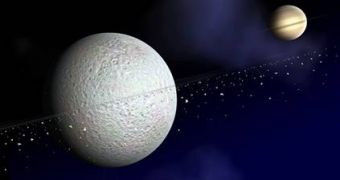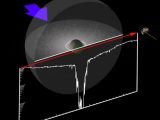The Saturn system is well known for its unique configuration. Being the second largest planet in the solar system, Saturn distinguishes itself from the other gas giants through a large ring of debris orbiting around it and the large number of moons - over 60 moons. Now Cassini promises to add yet another unique feature in the form of the first known moon to have its own ring system orbiting around it. The celestial body in question is Rhea, the second biggest moon in the Saturnian system.
However, unlike Saturn's ring of debris which is clearly visible in the optical spectrum, Rhea's is not, in fact nobody has ever had the opportunity to view it. Further still, the data collected by the Cassini spacecraft back in 2005 is rather ambiguous, but there are clues that there is definitely something there.
For now, we cannot say for certain that there is a ring of debris around Rhea, the data is inconsistent, but this is the only reasonable explanation we could find at that moment, according to Gerain Jones from the University College London, the lead researcher of the study related to Cassini's findings. The orbit of Rhea around Saturn takes it through the planet's magnetic field, which, as we know, is able to trap electrically charged particle and debris.
In anticipation for Cassini's fly-by around the small moon, Jones expected that, while Rhea swept the magnetic field of the planet, a larger amount of electrons would be absorbed into its surface. Additionally, the moon would be bombarded by micrometeorites which would rise a halo of dust from Rhea's surface. Indeed, the predictions were correct, but there was a second part of the story. The amount of charged particles around the moon decreases along a region in the vicinity of the planet about eight times its diameter, fact which could not be explained only by the presence of a dust halo created by meteorite fragments.
The data collected by Cassini shows that more than 70 percent of the electrons disappeared long before they could encounter the dust halo, which means that there is something else out there, still invisible to us, such as a very thin ring of dust orbiting around the moon.
John Spencer from the Southwest Research Institute, writes that, although there is no direct evidence that rings are present around Rhea, Cassini's findings still look very interesting. Jones agrees, but also points out that previous attempts to obtain physical evidence, such as a picture perhaps, have failed even while looking from a backward position in the closest orbit of the moon to the Sun. Backlighting techniques were also ineffective, however this doesn't necessarily mean that the ring of debris does not exist.
Calculations indicate that the drop in electron density is consistent with a ring of debris containing particles of material as large as a tennis ball, each one kilometer apart. The origin of the material could easily be explained by a meteor impact with Rhea's surface, forming rings that could remain in a stable configuration around the moon for more than one million years.

 14 DAY TRIAL //
14 DAY TRIAL // 
